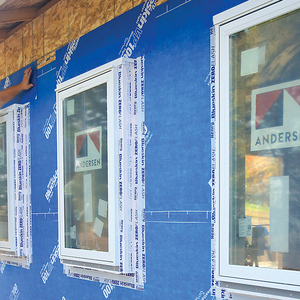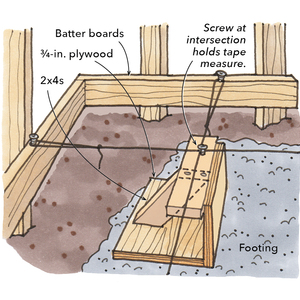*
My brother in law in changing his stairs from carpeted to hardwood and will be taking them apart and putting down hardwood to be exposed. He has told me that he can get premade treads but that he just needs to cut them to length. That is where we are stumped. Not sure what to use to cut them. Don’t necessarily want to buy a table saw for just one project. We were thinking about maybe a compound miter although we would need to flip the treads over to complete the cut. Another though I had was to use a circular with a good blade and a straight edge type of guide. Something that could be clamped onto the tread to guide the saw. What do you folks think? Thanks, rich and mark.
Discussion Forum
Discussion Forum
Up Next
Video Shorts
Featured Story

A rear addition provides a small-scale example of how to frame efficiently.
Highlights
"I have learned so much thanks to the searchable articles on the FHB website. I can confidently say that I expect to be a life-long subscriber." - M.K.
Fine Homebuilding Magazine
- Home Group
- Antique Trader
- Arts & Crafts Homes
- Bank Note Reporter
- Cabin Life
- Cuisine at Home
- Fine Gardening
- Fine Woodworking
- Green Building Advisor
- Garden Gate
- Horticulture
- Keep Craft Alive
- Log Home Living
- Military Trader/Vehicles
- Numismatic News
- Numismaster
- Old Cars Weekly
- Old House Journal
- Period Homes
- Popular Woodworking
- Script
- ShopNotes
- Sports Collectors Digest
- Threads
- Timber Home Living
- Traditional Building
- Woodsmith
- World Coin News
- Writer's Digest


















Replies
*
Richard , is it an open or closed stringer? It matters because you must return the bullnose on an open stringer ,which could reqire an entirely diferent process.
*"he just needs to cut them to length."Right, and maybe rip them, or even scribe them to skirtboards that are beat up, (and should be replaced). I would even bet the risers should be replaced, and ripped, cut, scribed.Would he like to install a little cove moulding? Would he like to know how to make a jig to fit between closed skirts? Has he honed his carpentry skills well enough to attempt a highly skilled job such as this, even though he has no tools? Does he know the proper overhang for the treads? Etc, etc, etc.To answer your question, yes, a circular saw will do this job, in place of a sliding miter and table saw. What circular saw did you have in mind?
*I've gotta agree with Qtrmeg on this one... This is kind of a difficult bit of carpentry to be attempting with improper tools and limited ( I'm assuming) experience. The open vs.enclosed stairway question being a biggie. Give us some more details and we may be able to talk you through this, but be prepared to reach the point where you may have to admit that you have gotten in over your head.
*Thanks for the responses. This is a closed stringer and what he wanted to just replace the treads with premade, hardwood treads that just need to be cut. The question he was asking was what was the best way to cut the treads which already has the bullnose attached.
*a circular saw with a good finish blade....but you do have to make a jig or a template (pattern) so you can start with WHAT you have to cut...you MAY be able to use the old treads as patterns but since they were carpet grade, it's doubtful...also.. were the old treads daddoed in ?proceed with caution...or....throw caution to the wind and buy some nice oak cove molding...the best finish guy on the crew gets this job...
*A sliding compound mitersaw is the best tool for the job. I have a Bosch and it's a great tool especially for $700. If you don't want to buy one, rent it.
*bs... best (?) tool for the job...?come on .. it's a bunch of oak treads ... gimme a break...
*Okay, now we know it's a closed stringer. Next question is what is the existing tread made of that's under the carpet and why does it need replacing? Pine to oak? Rough made 2x just covered with carpet? or is it oak already that can just be refinished?
*Richard, this link shows a jig for marking stair treads>>> stair jigI make them out of a piece of ply, with ply cut about 6" x the tread depth at each end, attached in a slot with carriage bolts & wing nuts. Place the ply to the riser, slide the end ply tight to the skirts, and tighten the bolts. Any version of this jig will give you a place to start marking your treads. It will also show you how the treads need to be fit to any irregularity. You can approximate this with the saw cut, but if you leave the tread a bit long you can scibe it and finish fit it with something like a stationary beltsander, disk sander, or plane. You also need to watch if you are pushing the skirts in as you do this, if you do you will be opening the riser below each tread. If this stairway has been in place for any time you will find that the area of the skirt that you have to fit to has been beat to a new shape by vacuuming, etc. Good luck fitting to that, you might be able to clean that area up a bit first. I also cut one end of the tread at less than a 90 degree, so the tread slides down without wrecking the skirt, but I am not sure how people around here feel about that, or anything else I do for that matter. And my question about which circular saw was not to pick on you, I have zero use for cheap saws.
*Richard,As you can see, cutting treads is not for the faint of heart. And on a closed stringer, if you put the second one in too tight, it will open a gap up on the first one. Don't plan on cutting any of them "square".......you'll just end up with a mess unless you don't know the difference. In that case, it'll look just fine.It's not the saw in this case.......it's the sawyer.Ed.
*Ed... Is that Tom Sawyer? lol... Qtrmeg... Nice link! I keep telling myself i'm gonna buy me one of those fancy stair tread jigs one of these days. But the homemade ones have been faithful for this long, I'll most likely never talk myself into spending the bucks. I've never added treads and left the old skirt board, I imagine you probably would have to do some funky scribing depending on how beat up it is. Richard... what about the risers? Is bro. in law planning on adding oak risers? I can't imagine the old carpeted risers are going to be anything you can use for a finished product. Perhaps some 1/4" oak veneer plywood ripped down to fit and nailed over them?
*Mark, don't thank me, that link is from the Fine Homebuilding webpage.As far as buying a "fancy" jig, Ha, that would be the day. I make them in minutes out of whatever is laying around. I also like to have the part that rests againt the riser full length, so I can see what I am up against there. Also nice is to be able to make the side pieces the same width of the treads.Another jig I make is for making the nosing miter in the tread. Made for a tablesaw to take the place of the miter gauge, take 2 pieces of ply and make an upside down T shape, attach another piece of ply vertical, to sandwich the tread. Add a piece of something to run in the miter groove, and keep the jig square to the blade. Finish the crosscut on the sliding miter saw. A new topic on the different jigs people use would be interesting, the two I mentioned are pretty basic stuff, there are many more interesting ones out there.
*
My brother in law in changing his stairs from carpeted to hardwood and will be taking them apart and putting down hardwood to be exposed. He has told me that he can get premade treads but that he just needs to cut them to length. That is where we are stumped. Not sure what to use to cut them. Don't necessarily want to buy a table saw for just one project. We were thinking about maybe a compound miter although we would need to flip the treads over to complete the cut. Another though I had was to use a circular with a good blade and a straight edge type of guide. Something that could be clamped onto the tread to guide the saw. What do you folks think? Thanks, rich and mark.